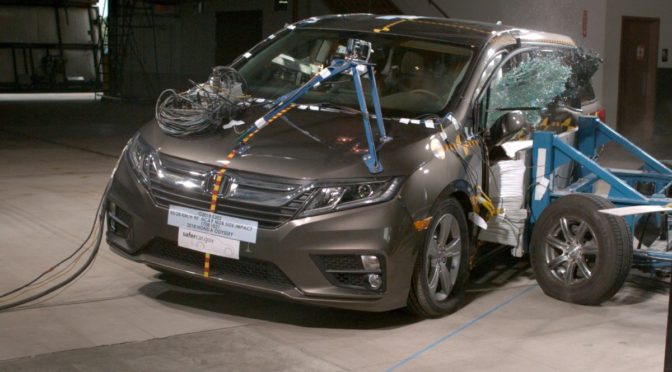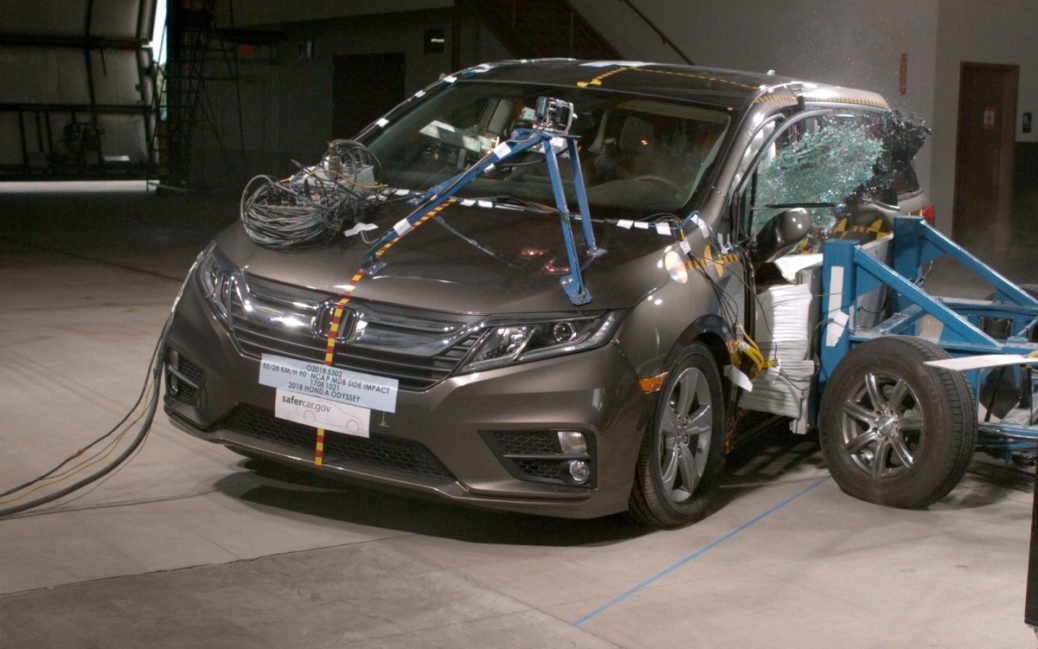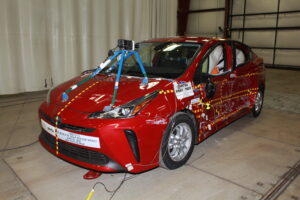
A few years ago, I wrote about how the IIHS had begun to design a replacement side impact test to address some of the shortcomings I’d identified in the original test. In particular, I hypothesized that the IIHS’ threshold for a “good” level of structural impact resistance–at least 12.5 cm of space between the B-pillar and the centerline of the driver’s seat after impact with a 3300 lb barrier traveling at 31 mph–was not enough to keep occupants safe. I based my hypothesis on the various case studies I’d profiled involving frontal and side impacts as well as on calculations of kinetic energy changes across impact speeds (for example, the fact that a head-on crash at 55 mph is the equivalent of being pushed out of the 10th floor of a building).
My theories led me to write a range of articles illustrating the leaders in side impact resistance across vehicular classes, from small- and mid-sized cars to station wagons to minivans to SUVs. As the years progressed, the centerline distance increased with each generation of vehicles tested by the IIHS, reflecting improvements in engineering in new vehicles throughout the country and greater attention paid to side impact safety. I’m happy to say that the day has arrived!
The IIHS modified their side impact test in late 2021 as they acknowledged that high speed side impact crashes still caused a significant number of fatalities in vehicles with “good” side impact scores. What were the changes, and how much of a difference are they likely to make? We’ll take a dive into these questions below, and as usual, the emphasis will be on best practices, and not simply on a blind trust that institutional standards are good enough, because as we’ve learned through decades of public health failures (leaded gasoline, CFCs, asbestos, auto safety, opioids, climate change, and most recently, the COVID-19 pandemic), institutional standards are almost never where they need to be.
What changes did the IIHS make to their side impact crash test?
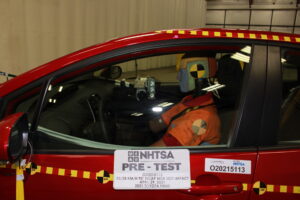 The main changes the IIHS made to the side impact protocol involved barrier mass, velocity, height, and contact surface. Two of these changes were good. Two of these changes were not necessarily good ones.
The main changes the IIHS made to the side impact protocol involved barrier mass, velocity, height, and contact surface. Two of these changes were good. Two of these changes were not necessarily good ones.
The barrier mass change was a good one; the weight was increased from 3,300 pounds, or that of a mid-sized car or small SUV, to 4,200 pounds, or that of a large car, mid-sized SUV, or minivan.
The velocity change was a good one; the barrier contact speed was increased from 31 mph to 37 mph.
The contact surface change was not a good one in my books. Per the IIHS; it was softened in order to permit it to bend around the B-pillar in order to compromise occupant space by the front and rear doors despite the presence of a strong B pillar. However, when discussing the limitations of the original side impact test, the IIHS also directly admitted that in real-world crashes, vehicles of a given weight produced more damage due to less forgiving (read: stiffer) fronts than the deformable barrier, which acted somewhat like a pillow when impacting the tested vehicles.
The increased danger of rigid barriers is highlighted well in the NHTSA side pole test, in which a vehicle is driven sideways at a 75 degree angle and at 20 mph into a rigid pole 10 inches in diameter; this is designed to simulate a telephone pole or tree strike. While the IIHS claims that their original and side tests result in more damage than this test, I completely disagree, and find both tests complement each other. The NHTSA test is a frightening one, as the intrusion is tremendous despite the relatively low speed; it is easy to see how such a crash could and would result in fatal cranial trauma despite the low speeds, and it provides all the evidence necessary that rigid barriers, pound for pound, are far more threatening than deformable ones.
Similarly, the height change was not a good one in my books. The IIHS lowered the height of the barrier under the argument that a lower barrier would better replicate the damage of an SUV strike than that of the prior barrier. I’m not a fan of it because it reduces strain on the B pillar and threats to driver’s heads (as represented by HIC-15 forces) by concentrating striking forces closer to the ground where the vehicle is stronger, rather than toward the cabin, where everything we value is located.
How do IIHS side impact crash test changes translate to real world safety differences?
 This is where things get interesting; we’ve seen the science, but now we need the engineering. When I wrote about the limitations of the original IIHS side impact test, my wish list included a 4,000 pound barrier and a 40 mph impact speed. I got a little of both; the barrier mass exceeded my expectations but the impact speed fell below them. Unfortunately for us, the impact speed matters more. Let’s look at the math.
This is where things get interesting; we’ve seen the science, but now we need the engineering. When I wrote about the limitations of the original IIHS side impact test, my wish list included a 4,000 pound barrier and a 40 mph impact speed. I got a little of both; the barrier mass exceeded my expectations but the impact speed fell below them. Unfortunately for us, the impact speed matters more. Let’s look at the math.
To calculate the test forces, we’ll use kinetic energy = 1 / 2 * mass * velocity * velocity.
The original test featured k = .5 * 1497 kg * 13.9 m/s * 13.9 m/s, or 143.7 kJ, or kilojoules of energy.
Per the IIHS, real world studies indicate that drivers of vehicles with “good” scores on the original test are 70% less likely to die from direct side impacts vs drivers of “poor”-rated vehicles. This advantage drops to 64% with “acceptable” vehicles and 49% with “marginal” vehicles. These are, frankly speaking, great advantages. But where are we going now?
My wish list test of 4,000 pounds and 40 mph results in 290.1 kJ. This is 202% as much force as that in the original IIHS test, or 102% more.
The new IIHS test at 4,200 pounds and 37 mph results in 260.6 kJ. This is 181% as much force as that in the original IIHS test, or 81% more. The IIHS lists it as 82% more, so we’re in the same range.
However, notice the difference between my wish list and their revision: although they added more weight than I was hoping for, the fact that they only boosted speed by 6 mph instead of my 9 mph to hit an even 40 mph means a test that’s significantly less impactful, if you’ll excuse the pun. As we’ve discussed over and over and over again, speed matters more than almost anything else. A 4,000 pound vehicle traveling at 40 mph will do significantly more damage than a 4,200 pound vehicle traveling at 37 mph.
That said, it’s still worth celebrating that the IIHS is using a test that’s more reflective of real world crashes. It is significant (and disappointing), however, that they chose a lower speed to give car manufacturers an easier time to meet the new standard instead of pushing them to do more and save more lives by putting more effort into high end engineering. Forty miles per hour is a natural testing speed upgrade; it’s what the IIHS uses universally in frontal crashes. The main reason to avoid using such a speed in side crashes is because it’s much harder to engineer a vehicle that will let you walk away from a 40 mph side impact than it is to engineer one that will do the same with a 40 mph frontal crash, as there is far less space between the driver and the barrier in a side impact crash than there is in a frontal crash.
Is it worth buying a vehicle tested under the new standard if I already have a “good” vehicle under the old side impact test?
This is perhaps the most difficult question of all to answer. It really depends on your risk tolerances and budget. Personally, if I had a vehicle that already tested well on the original IIHS test, I would not rush to upgrade in order to get the newer technology. It’s absolutely an improvement, but if you’ve got a vehicle with “good” scores on the old test, you almost certainly have a vehicle that has the other essential elements in vehicular safety: good frontal scores and ESC. If you’ve got these, your vehicle is good enough, and you’ll get far more out of focusing on how you’re driving and on where you’re driving. These are the main factors in whether or not you make it home, especially once you have a decent vehicle.
 If you find my information on best practices in car and car seat safety helpful, you can buy my books here or do your shopping through this Amazon link. Canadians can shop here for Canadian purchases. It costs nothing extra to do so, but when you shop through my links, a small portion of your purchase, regardless of what you buy, will go toward the maintenance of The Car Crash Detective.
If you find my information on best practices in car and car seat safety helpful, you can buy my books here or do your shopping through this Amazon link. Canadians can shop here for Canadian purchases. It costs nothing extra to do so, but when you shop through my links, a small portion of your purchase, regardless of what you buy, will go toward the maintenance of The Car Crash Detective.

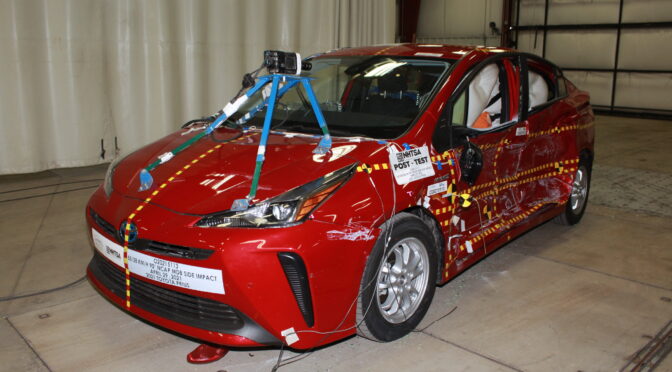
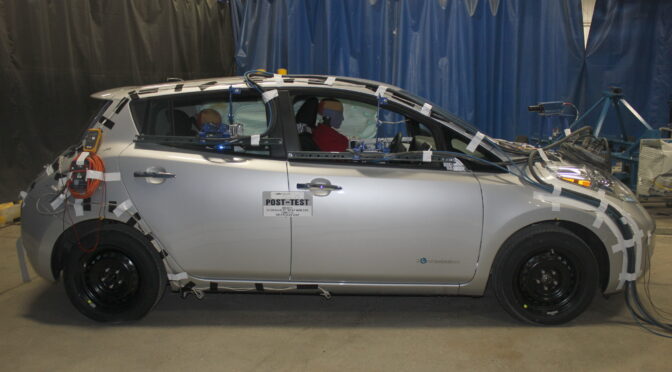
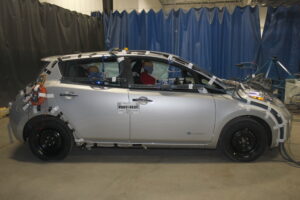
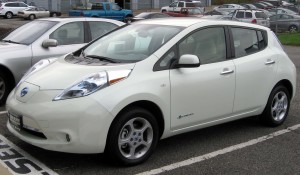 According to the IIHS report, the Nissan Leaf, a small electric car, had a driver death rate of 5 in the 2014-2017 model years, with five predicted fatalities occurring from single vehicle crashes and none from multiple vehicle crashes. These predictions were based on an exposure of 164,259 registered vehicle years and a 95% confidence bound of 0-14.
According to the IIHS report, the Nissan Leaf, a small electric car, had a driver death rate of 5 in the 2014-2017 model years, with five predicted fatalities occurring from single vehicle crashes and none from multiple vehicle crashes. These predictions were based on an exposure of 164,259 registered vehicle years and a 95% confidence bound of 0-14.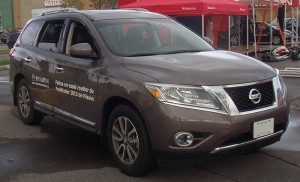 Next we take a look at the 4WD trim level of the 2014-2017 Nissan Pathfinder. The IIHS predicted a driver death rate of 20 between 2015-2018, with 7 predicted fatal multiple vehicle crashes and 14 fatal single vehicle crashes with 12 of them occurring from rollovers. As we’ve seen in a number of other death rate analyses, the crash figures don’t add up to the predicted death rate due to statistical rounding. The exposure came from 450,004 vehicles years with a confidence bound of 3 to 37.
Next we take a look at the 4WD trim level of the 2014-2017 Nissan Pathfinder. The IIHS predicted a driver death rate of 20 between 2015-2018, with 7 predicted fatal multiple vehicle crashes and 14 fatal single vehicle crashes with 12 of them occurring from rollovers. As we’ve seen in a number of other death rate analyses, the crash figures don’t add up to the predicted death rate due to statistical rounding. The exposure came from 450,004 vehicles years with a confidence bound of 3 to 37.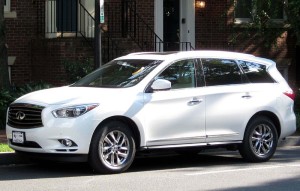 The Infiniti QX60 is essentially the Nissan Pathfinder with additional luxury features. A potential advantage of the QX60, which was formerly known as the JX35, over the Pathfinder, is the inclusion of advanced safety features such as lane departure or blind spot warnings.
The Infiniti QX60 is essentially the Nissan Pathfinder with additional luxury features. A potential advantage of the QX60, which was formerly known as the JX35, over the Pathfinder, is the inclusion of advanced safety features such as lane departure or blind spot warnings.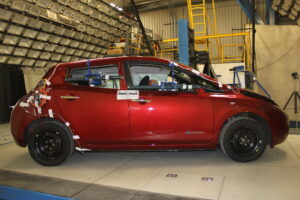
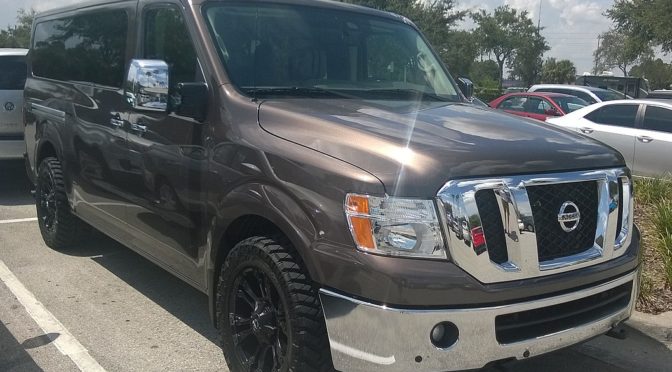
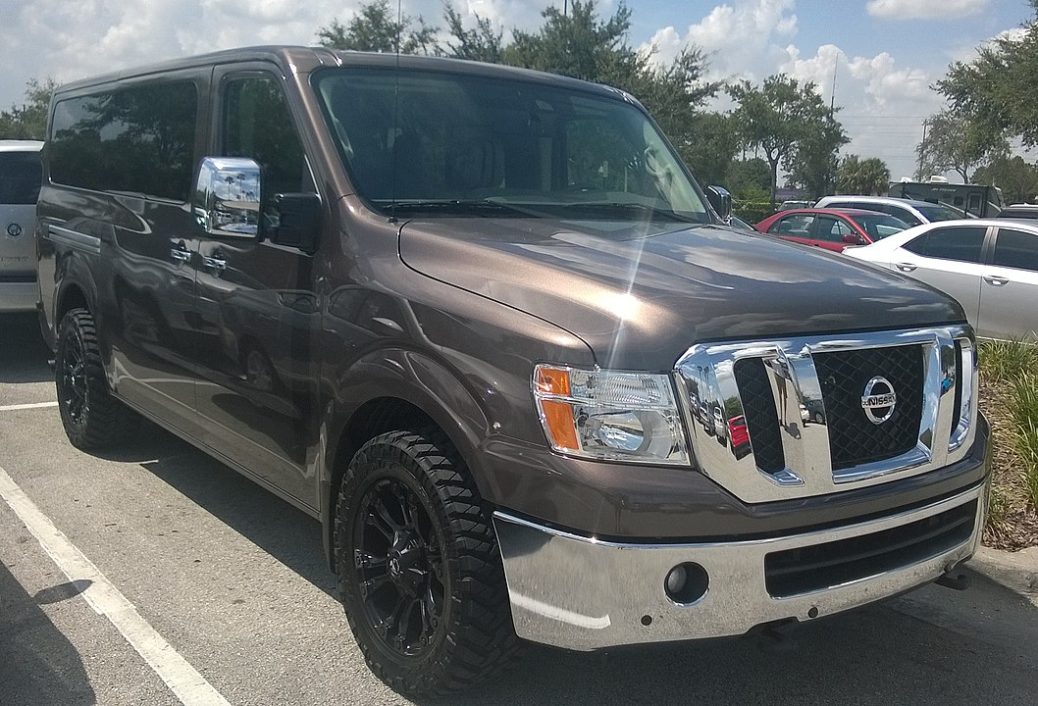
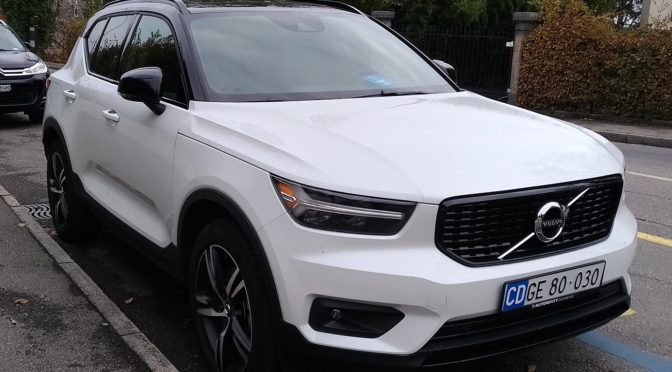
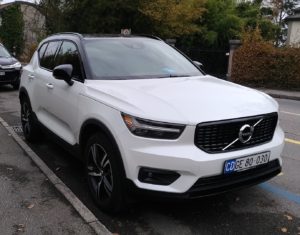 2018, 2019, 2020 Volvo XC40
2018, 2019, 2020 Volvo XC40